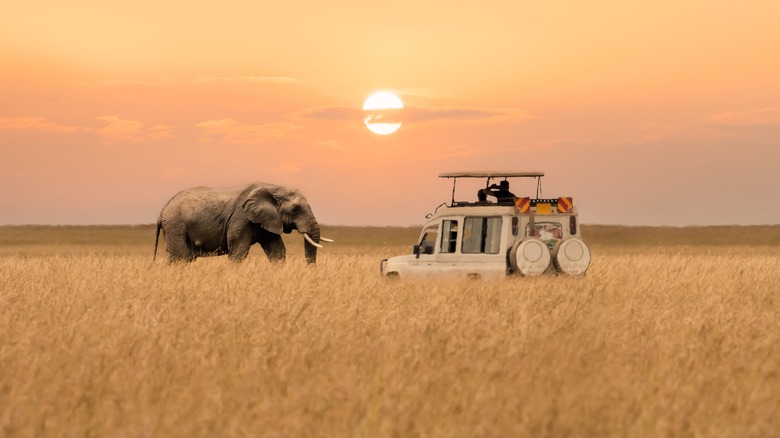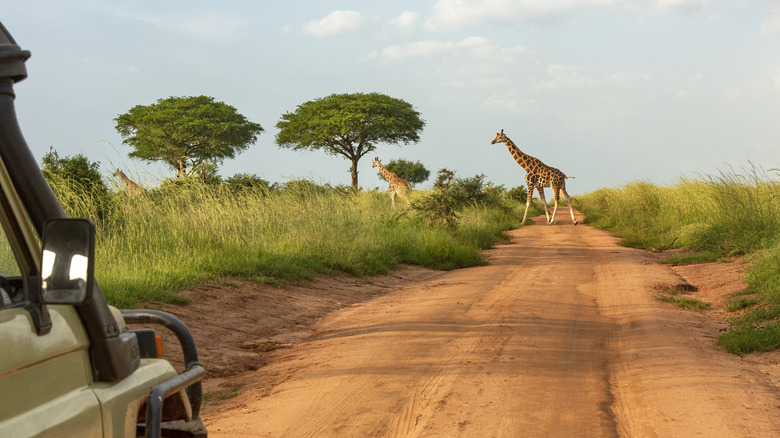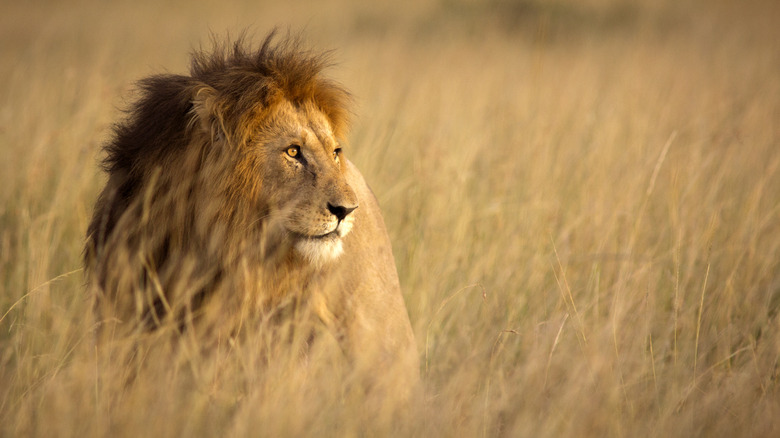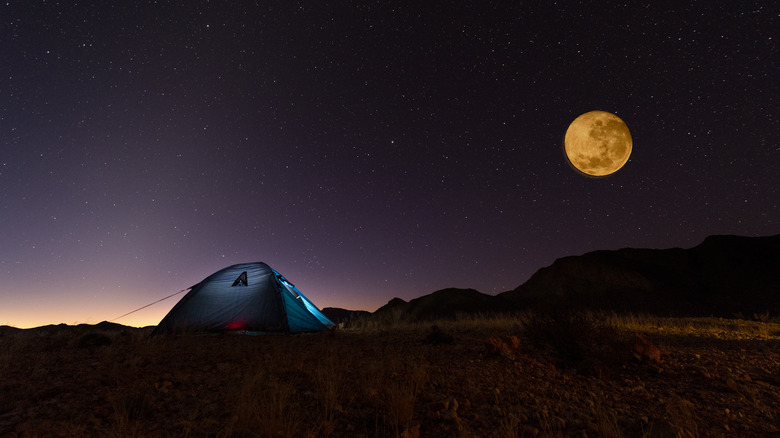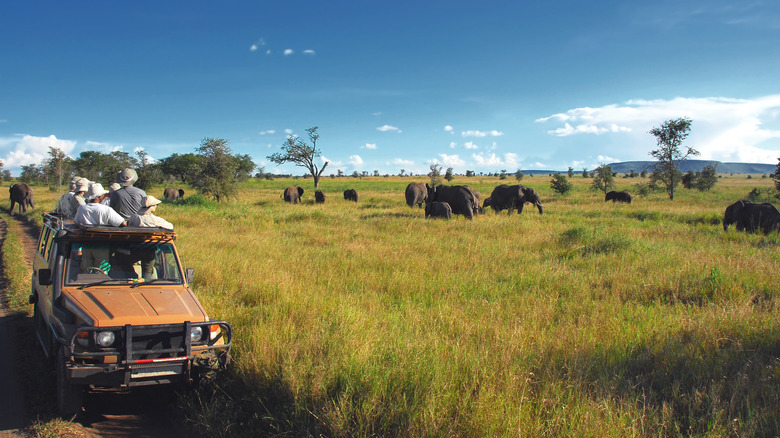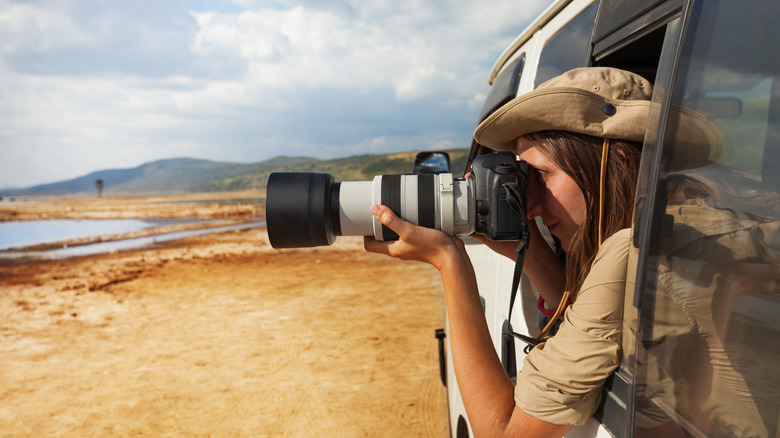Unexpected Things Tourists Should Know Before Their First African Safari
We may receive a commission on purchases made from links.
One of the biggest bucket list adventures in the world is going on an African safari. An African safari involves going on game drives, often more than one, which are essentially when you go out on a drive to catch your best chance at seeing animals. While game drives are the main attraction of an African safari, they're only a fraction of what to expect on a typical adventure. A lot of planning (most people plan their African safari a year in advance), preparation, and packing needs to be done strategically in order to maximize your comfort on your big African venture. Mind you, Africa consists of 54 nations, so much of this depends on where on the continent you'll go (more on that later).
While some things might seem obvious about going on an African safari, like bringing binoculars, seeing animals, needing visas, and having the absolute best time of your life, there are other things you might not know. Luckily, we've done the leg work of research for you, and we're here to give proper tips on some unexpected factors that you should know prior to your first African safari.
Wear the appropriate attire
If you've ever had a close friend or family member who's taken an African safari, you've likely seen them in olive, beige, and neutral colors. Even if you've seen stock photos of people on an African safari, they are almost always in earth tones — and it's no coincidence. Wearing bright colors on an African safari can distract the animals, so it's recommended to do your best to blend in with your surroundings. Not only that, but certain colors can attract bugs, like how bright colors and very dark colors (blue and black) can attract tsetse flies.
Another surprising factor regarding how to dress when going on an African safari is that, despite popular misbelief, it's not always scorching hot. While this obviously depends on what time of year you visit along with which countries you go to, temperatures in sub-Saharan nations like Botswana and Zambia, for example, can drop to below freezing at night. Since many game drives begin early, often before the sun has risen, you'll want to ensure you bring layers.
The animals you see will depend on where you go
The typical goal of going on an African safari is to catch sighting of the Big Five: lions, elephants, leopards, rhinos, and buffalo. Some parks with the best chances of sighting all of them are Chobe National Park in Botswana, Kruger National Park in South Africa, and Majete Wildlife Reserve in Malawi. More specifically, Chobe National Park will leave you with pretty good odds of seeing an elephant or two, since Botswana has the largest elephant population in the world with an estimated total of about 130,000 of them. If you're more interested in leopards and big cats, Kruger National Park is the place to go. Speaking of big cats, lions are almost always spotted in Serengeti National Park in Tanzania.
Aside from the Big Five, if you want to see gorillas, you'll have to go to either Uganda, Rwanda, or Democratic Republic of the Congo. Permits can be costly, at $1,500 per person in Rwanda, $800 in Uganda, and $400 in the Congo. Interested in hippos? Head to the Okavango Delta, which is technically located in Botswana but is accessible via Namibia as well.
The primary caveat to keep in mind is that even if you strategically choose the right safari for you, these animals are in their natural habitat, and therefore, nothing is guaranteed. You're likely to come across species of animals you didn't even consider when planning, so be patient and enjoy the learning process.
Lodging ranges from camping to luxury
You might assume that being out in the wild means you'll solely sleep in rugged conditions, but that is not always the case. Lodging entirely depends on how you plan your trip, whether you use a tour company (which most people do, since planning the logistics of a trip like this can be tricky), your general preference, and, of course, your budget.
Let's start with the luxury options. There are indeed plenty of glamping and five-star experiences throughout popular safari destinations on the continent. If you're craving a visit to Victoria Falls, The Royal Livingstone Victoria Falls Zambia Hotel by Anantara, a five-star resort located on the Zambezi River, is known as one of the best hotels on the continent. Four Seasons Safari Lodge Serengeti is a luxe experience that's conveniently located next to a watering hole, meaning you'll have the chance to see many animals, including the Big Five, right from the convenience of the hotel. If you're interested in being pampered after gorilla trekking, Virunga Lodge in Rwanda offers private butlers after your long days of exploring.
If you're more into a gritty outdoor experience, consider booking a camping overland adventure. G Adventures offers a 19-day camping trip that takes you from Kampala, Uganda, to Stone Town, Zanzibar. Exodus Adventure Travels offers a 20-day Victoria Falls to Cape Town outdoor camping experience. For a shorter getaway, go for the 10-day East Africa Highlights camping trip with Intrepid Travel, starting in Nairobi, Kenya, and ending in Arusha, Tanzania.
Bring things you wouldn't expect to bring
It's not only clothing and where you're going that needs some additional thought — you'll also want to bring the appropriate items to make your journey more comfortable. African game drives often mean long days that start early, and since you're going to be in some seriously remote parts of the world, know that your cell service and Wi-Fi is likely to be limited. Because of this, you'll want to consider downloading some type of entertainment, whether a podcast or an audiobook, or simply bringing a book or even a journal.
There's a funny phrase that you're likely to hear on your journey: "African massage." This is not a literal spa experience, but instead, attributed to the inevitable bumps you will face on some of the unpaved roads in parks. Your body is going to feel its effects, so consider bringing something that will help soothe your muscles, like compression socks or a travel-sized massage gun such as Hyperice Hypervolt Go 2.
With a beaming sun and long days, staying hydrated is crucial. Since you won't always have access to clean water, it's wise to bring a water bottle with a built-in filter. One great option for this is the GRAYL UltraPress Purifier. Keep in mind that water filters aren't perfect (especially cheap ones), and you should still follow basic water purification practices, like boiling water.
Your camera seriously matters
You know the old saying: Pics or it didn't happen. Bringing the right camera will seriously enhance the photos you take, and an African safari is one trip that's worth upping your photography skills for.
Luckily, phone manufacturers have been working diligently to upgrade their cameras, so you could risk simply bringing your iPhone or Android and relying on portrait mode. However, it should be noted that oftentimes, animals are quite far away, and zooming in a significant amount on a phone camera often creates a pixelated, gritty effect. The biggest features to look for in your camera of choice is that you have a good zoom lens and a camera that can capture movement to avoid blurry photos.
If you want to invest in a better camera without breaking the bank, consider the Nikon D5000 for a compact camera that's easy to travel with. Note that the quality of the photos is heavily dependent on the lens you use, and since zoom is key here, consider a Nikon Z5 Mirrorless Camera, which has a 24-200mm lens, but is unfortunately extremely expensive. If you're worried about a camera taking up ample luggage space, consider bringing a DJI Osmo Pocket 3 or a GoPro Hero12, though it's important to note that neither of these products zoom nearly as much as other more traditional options, so animals will need to be a bit closer to capture.
